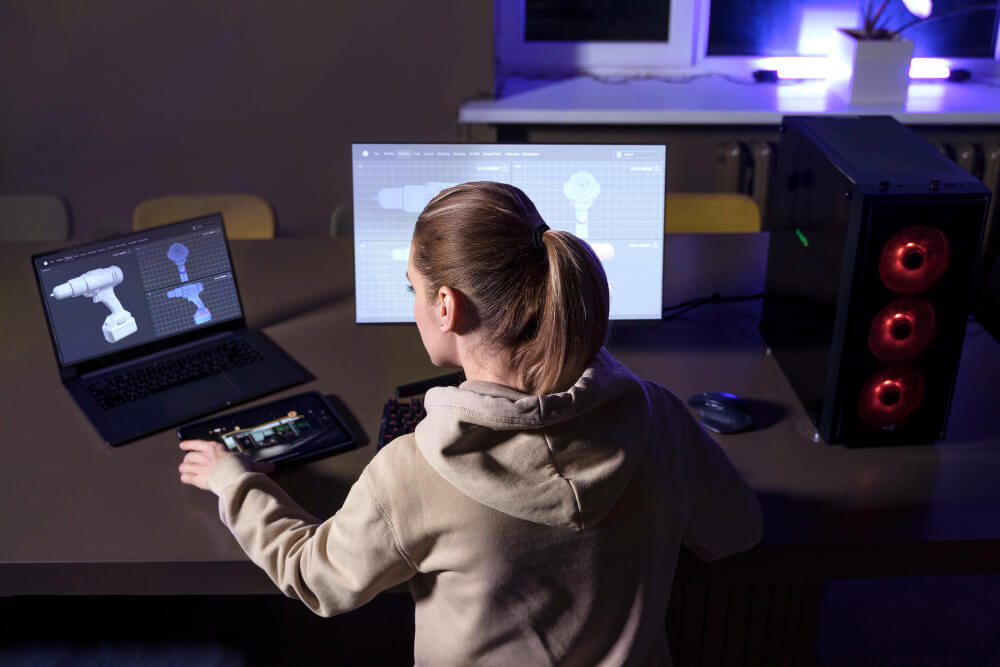How many monitors does a web developer need?

The tools and technologies available to developers are constantly expanding. One question that frequently arises is how many monitors a web developer should have for an optimal workflow. The answer is not a one-size-fits-all solution; rather, it depends on various factors, including personal preference, the nature of the work, and budget constraints. In this discussion, we'll explore the considerations that can help web developers determine the ideal number of monitors for their setup. Additionally, we'll highlight the importance of considering ergonomic factors to enhance the overall efficiency of web development services.
- Understanding the Developer's Workflow:
- The Single Monitor Setup:
- The Dual Monitor Setup:
- The Triple Monitor Setup:
- Consideration for Specific Roles:
- Ergonomics and Physical Workspace:
- Budget Constraints:
- Software and Hardware Considerations:
Before diving into the number of monitors, it's crucial to understand the typical workflow of a web developer. Web development often involves coding, designing, testing, and debugging. Each of these tasks benefits from a different type of workspace. A multi-monitor setup can enhance productivity by allowing developers to have multiple applications and tools open simultaneously.
Some developers prefer a single monitor setup, arguing that it promotes focus and minimizes distractions. This minimalist approach forces developers to prioritize tasks and can be suitable for those who find multiple screens overwhelming. However, it may limit the ability to have multiple applications open simultaneously, potentially slowing down certain aspects of the development process.
A dual monitor setup is a popular choice among web developers, and it's one of the configurations web developers use the most. It provides a balanced approach, offering enough screen real estate to improve multitasking without overwhelming the workspace. With dual monitors, developers can have their code on one screen and a web browser, documentation, or a design tool on the other. This setup strikes a balance between focus and multitasking.
For developers working on complex projects or handling multiple tasks concurrently, a triple monitor setup might be the sweet spot. This configuration allows for even more multitasking, with one monitor dedicated to code, another to design tools, and a third for testing or documentation. The additional screen space can significantly boost efficiency, particularly for those who work with large codebases or multiple projects simultaneously.
The number of monitors can also depend on the specific role within web development. Front-end developers, for example, might benefit more from a dual or triple monitor setup as they often need to reference design mockups, code, and browser outputs simultaneously. Back-end developers, on the other hand, may find a dual monitor setup sufficient, as their focus is often on code and server-side functionality.
While the number of monitors is essential, so is the physical workspace. Consideration should be given to the size of the monitors, their resolution, and how they fit into the overall ergonomics of the workspace. Larger monitors with higher resolutions can provide a more immersive and detailed view, but they may require more desk space. It's essential to strike a balance between screen size, resolution, and available workspace to create a comfortable and efficient environment.
Another crucial factor is budget constraints. Monitors vary in price, and the cost can increase significantly with each additional monitor. Developers need to weigh the benefits of a multi-monitor setup against their budget limitations. It's worth noting that the increased productivity gained from additional screens could potentially offset the initial investment over time.
The effectiveness of a multi-monitor setup also depends on the software and hardware used. Some development environments and tools are optimized for multi-monitor use, while others may not fully exploit the additional screen space. Similarly, the computer's graphics card must be capable of supporting multiple monitors with adequate performance.
In the world of web development, the ideal number of monitors is subjective and dependent on various factors. Developers should carefully consider their workflow, job responsibilities, and personal preferences when deciding on a monitor setup. Whether opting for a single, dual, or triple monitor configuration, the key is to strike a balance between focus and multitasking to enhance productivity and create a comfortable working environment. Additionally, staying mindful of ergonomic considerations, budget constraints, and software/hardware capabilities will contribute to a well-rounded decision when choosing the optimal number of monitors for web development.
